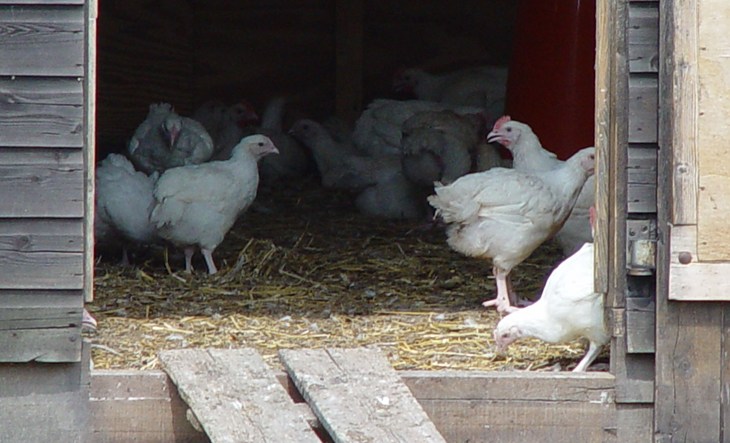Keeping animals confined to factory farms provides the perfect breeding ground for disease.
Although widely thought to have originated in wildlife, Covid-19 showed parallels with other viruses that stemmed from industrial animal farming. Swine flu and highly pathogenic strains of avian influenza, which originated in pigs and chickens respectively, are believed to come from keeping sentient creatures in confined conditions that provide the perfect breeding ground for novel strains of disease.
As with swine flu (H1N1), the respiratory disease that swept across the planet in 2009 and 2010 was a highly contagious virus containing genetic material from a mixture of pig, bird and human influenza, a combination never seen before. The disease strain, which was found to share genetic material related to both North American and European pigs, spread rapidly from country to country.
According to the US Centres for Disease Control and Prevention (CDC), swine flu was within a year responsible for the death of an estimated 151 to 575 thousand people worldwide.
Like swine flu a decade ago, the prospect that we will fail to learn the lessons of the current Covid-19 pandemic is a major concern.
When faced with a disease that involves farmed animals, the industry’s reaction is to lock livestock inside. The logic goes that if they are confined indoors in ‘biosecure’ units, animals must surely be protected, when the opposite is true.
Those intensive farm buildings provide the perfect breeding ground for new and more dangerous strains of disease. Keeping too many animals in a small space, – often dark, filthy and overcrowded – provides the conditions for a virus like avian influenza to spread. In this environment, the virus can pass through a flock of poultry, replicating rapidly, which is when differences can occur in the virus’s DNA. This is how new and more deadly strains of viruses can emerge. It should therefore be noted that keeping farmed animals indoors increases the risk of disease.
The report, "Preventing the next pandemic", by the UN Environment Programme (UNEP) and the International Livestock Research Institute (ILRI) identifies unsustainable agricultural intensification and increasing demand for animal protein as major drivers of zoonotic disease emergence. A report by the Intergovernmental Science-Policy Platform on Biodiversity and Ecosystem Services (IPBES) states: “The underlying causes of pandemics include… land-use change, agricultural expansion and intensification”.
Keeping animals confined in large numbers not only provides the perfect breeding ground for the emergence of new and more deadly strains of viruses, but also leads to antibiotic resistance.
Globally, over 70% of all antibiotics are used in farmed animals. Industrial production depends on the routine use of antibiotics to prevent the diseases that are inevitable when animals are kept in poor conditions. This leads to antibiotic resistance in animals which can then be transferred to people.
This is a major reason for the World Health Organization (WHO) warning that action is needed if we are to avoid a post-antibiotic era, where diseases that are currently treatable could once again kill. Experts have suggested that by the middle of the century, the demise of antibiotics could lead to 10 million deaths a year.
For the sake of human health and animal welfare, there is an urgent need to end factory farming. There is growing recognition in policy circles of the concept of ‘One health, one welfare’. Perhaps the most salient lesson from Covid-19 is that protecting people means protecting animals too.
Introduction to the problem and scale

- Unhealthy diets are the largest global burden of disease and pose a greater risk to morbidity and mortality than unsafe sex, and alcohol, drug, and tobacco use combined.2
- The prevalence of diet-related non-communicable diseases – including coronary heart disease, stroke, and diabetes – associated with high-calorie, unhealthy diets is increasing.3
- Non-communicable diseases, including cardiovascular disease, cancer and diabetes are responsible for 71% of deaths globally each year.4
- The burden of non-communicable diseases is rising disproportionately among lower-income populations and countries, accompanying a “nutrition transition” toward diets that are higher in animal-based foods, added sweeteners, and refined carbohydrates.5
- Antimicrobial resistance is increasing; it is now a global crisis that threatens a century of progress in health and achievement of the Sustainable Development Goals.6
- Each year, approximately 700,000 people die from drug-resistant diseases, and if no action is taken, this could increase to 10 million per year as early as 2050.7
- The cost of malnutrition is also an economic problem not only in terms of health care costs, but also in terms of loss of productivity within the workplace, with global estimates of $3.5 trillion lost.8
How does factory farming affect our health?

- High consumption levels of red and processed meat - which has been made possible by industrial animal farming - contributes to heart disease, obesity, diabetes, and certain cancers.9, 10, 11
- Free-range animals, which consume fresh forage and have higher activity levels, often provide meat of higher nutritional quality than animals that are reared industrially. Pasture-fed beef has less fat and higher proportions of omega-3 fatty acids than grain-fed beef12. The same applies to slower-growing chickens as compared to intensive fast-growing breeds and also to free-range vs indoor production.13
- Routine application of antibiotics in feed and water used to prevent disease and enhance growth is a major contributor to antibiotic resistance. 73% of all antibiotics are used in farm animals,14 and antibiotic use in animals is increasing worldwide.15

- Research shows that antibiotic use is lower in higher welfare systems for pigs and chickens than it is in intensive production16. In the Netherlands, where around 40% of chicken production uses slower-growing breeds of chicken to meet the health and welfare requirements of their retailers, these slower-growing breeds are consistently at least three times less likely to need antibiotic treatment than the fast-growing breeds that are kept for export.17
- Studies show that in some countries – including Denmark and the UK– agriculture is responsible for a larger proportion of the health problems arising from air pollution than transport or energy generation18. Air pollution is a serious problem for human health as it contributes to conditions such as bronchitis, asthma, lung cancer, and congestive heart failure.
Link to the relevant Sustainable Development Goal (SDG)
- SDG 3: Ensure healthy lives and promote well-being for all at all ages.19
- Michael Pollan, Food Rules: An Eater's Manual
- Health effects of dietary risks in 195 countries, 1990–2017: a systematic analysis for the Global Burden of Disease Study 2017. Published by the Lancet 2019
- Willett, W., Rockström, J., Loken, B., Springmann, M., et al 2019 Food in the Anthropocene: the EAT-Lancet-Commission on healthy diets from sustainable food systems. The Lancet
- World Health Organisation. Key Facts. June 2018.
- Popkin, Barry M. 2015. Nutrition Transition and the Global Diabetes Epidemic.
- NO TIME TO WAIT: SECURING THE FUTURE FROM DRUG-RESISTANT INFECTIONS, Interagency Coordination Group on Antimicrobial Resistance. Report to the Secretary-General of the United Nations April 2019 Summary of Recommendations and Key Messages.
- World Health Organisation. Newsroom Detail. April 2019.
- Branca, F., Lartey, A., Oenema, S., Aguayo, V.,Stordalen, G.A., Richardson, R., Arvelo, M., Afshin, A., 2019 Transforming the food system to fight non-communicable diseases. The British Medical Journal.
- Friel, S., Dangour, A.D., Garnett, T., Lock, K., et al, 2009. Health and Climate Change 4: Public health benefits of strategies to reduce greenhouse-gas emissions: food and agriculture. Published online November 25, 2009 DOI:10.1016/S0140-6736(09)61753-0
- Aston LM, Smith JN and Powles JW, 2012. Impact of a reduced red and processed meat dietary pattern on disease risks and greenhouse gas emissions in the UK: a modelling study. BMJ Open Vol 2, Issue 5
- Anand, S.S., Hawkes, C., de Souza, R.J., Mente, A., et al 2015.Food Consumption and its Impact on Cardiovascular Disease: Importance of Solutions Focused on the Globalized Food System. Journal of the American College of Cardiology, 66, no 14
- Research reviewed in Nutritional benefits of higher welfare animal products, 2012. Compassion in World Farming.
- Compassion in World Farming, 2012. Nutritional benefits of higher welfare animal products.
- Keep Antibiotics Working Campaign. Public Health England 2018.
- Stop using antibiotics in healthy animals to prevent the spread of antibiotic resistance. World Health Organisation. Newsroom 2017
- Alliance to Save Our Antibiotics, 2017. Real farming solutions to antibiotic misuse.
- Compassion in World Farming, 2020, quoting industry data. Dutch slower growing chickens require less antibiotics than fast growing chickens. Data used comes from the Dutch industry’s Avined website.
- B Brandt, Jørgen & Silver, Jeremy & Frohn, L. & Christensen, Jesper & Andersen, Mikael & Bønløkke, Jakob & Sigsgaard, Torben & Geels, C. & Gross, Allan & Hansen, Ayoe & Hansen, K. & Hedegaard, G. & Kaas, Eigil. (2011). Assessment of Health-Cost Externalities of Air Pollution at the National Level using the EVA Model System. CEEH Scientific Report No 3.
- United Nations Department of Economic Social Affairs Sustainable Development